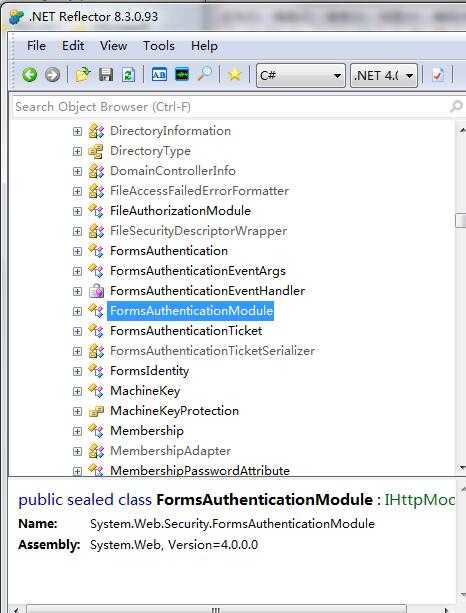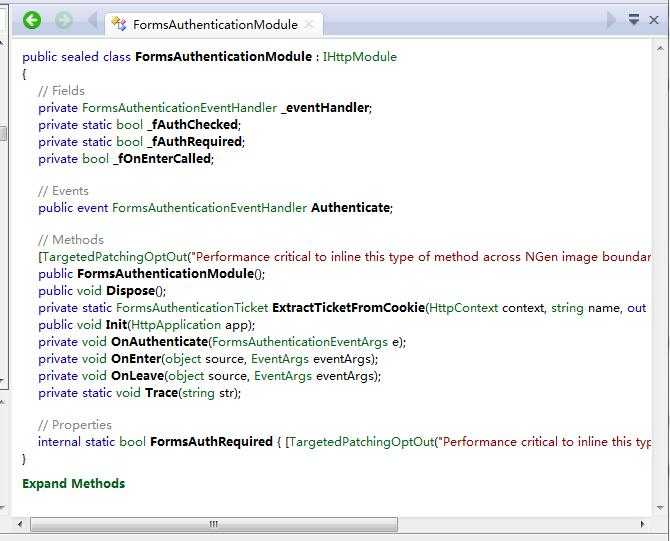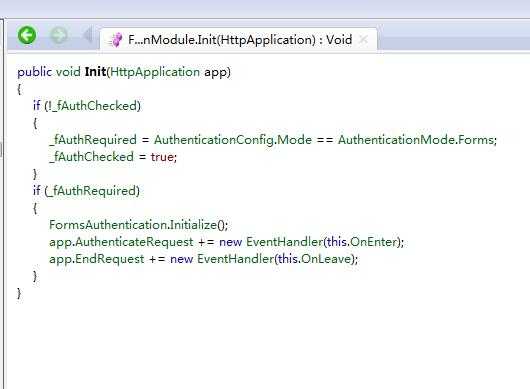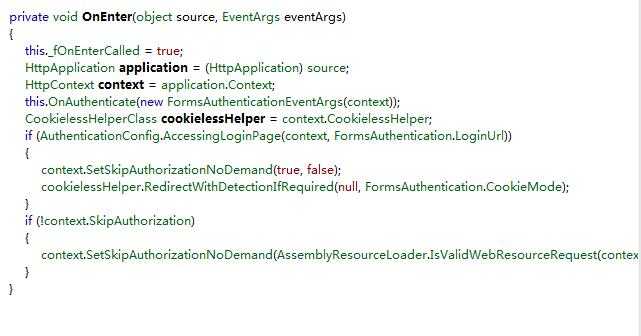标签:tca 方法 ast inf new nstat alt == bool
HttpModule是用来注册HttpApplication事件的,实现IHttpModule接口的托管代码模块可以访问该请求管道的所有事件。那么对于我们最常用的ASP.NET Forms身份验证模块是如何底层封装处理的呢?
今天过了一遍ASP.NET生命周期,以前的时候喜欢做各种应用,小程序等,渐渐地就觉得真没意思,因为只要你懂点基本的语法,会用相关的库亦或是框架就行,如果出错就是些许的细节错误,严格来说这不锻炼人,这有点像是温水煮青蛙,当然不能说这不好,这可以帮我们熟练地掌握框架的使用,增加熟练度及相关基础的应用,但是就个人而言老觉得缺点什么...后来想想,我要做的其实就是让别人用我开发的框架,库,我想研究的是框架底层的架构而不是用框架。于是过了一遍生命周期,处了IIS处理请求部分实在不懂之外,对ASP.NET处理请求还是更熟练了,对于不懂得我不会去刻意强求懂,毕竟自己的技术深度,广度摆在那,日后到了时候自然会懂。IIS7较之于之前的版本,其扩增了一个集成模式。IS 7.0 集成管道是一种统一的请求处理管道,它同时支持本机代码和托管代码模块。实现 IHttpModule 接口的托管代码模块可访问该请求管道中的所有事件。例如,托管代码模块可用于 ASP.NET 网页(.aspx 文件)和 HTML 页(.htm 或 .html 文件)的 ASP.NET Forms 身份验证。即使 IIS 和 ASP.NET 将 HTML 页视为静态资源,情况也是如此。
从功能上讲,HttpModule之于ASP.NET,就好比ISAPI Filter之于IIS一样。IIS将接收到的请求分发给相应的ISAPI Extension之前,注册的ISAPI Filter会先截获该请求。ISAPI Filter可以获取甚至修改请求的内容,完成一些额外的功能。与之相似地,当请求转入ASP.NET管道后,最终负责处理该请求的是与请求资源类型相匹配的HttpHandler对象,但是在Handler正式工作之前,ASP.NET会先加载并初始化所有配置的HttpModule对象。HttpModule在初始化的过程中,会将一些功能注册到HttpApplication相应的事件中,那么在HttpApplication整个请求处理生命周期中的某个阶段,相应的事件会被触发,通过HttpModule注册的事件处理程序也得以执行。
所有的HttpModule都实现了IHttpModule接口,下面是IHttpModule的定义。其中Init方法用于实现HttpModule自身的初始化,该方法接受一个HttpApplication对象,有了这个对象,事件注册就很容易了。
ASP.NET提供的很多基础构件(Infrastructure)功能都是通过相应的HttpModule实现的,下面类列出了一些典型的HttpModule:
OutputCacheModule:实现了输出缓存(Output Caching)的功能;
SessionStateModule:在无状态的HTTP协议上实现了基于会话(Session)的状态;
WindowsAuthenticationModule + FormsAuthenticationModule + PassportAuthentication- Module:实现了3种典型的身份认证方式:Windows认证、Forms认证和Passport认证;
UrlAuthorizationModule + FileAuthorizationModule:实现了基于Uri和文件ACL(Access Control List)的授权。
抱着吹毛求疵的学习态度,我研究了一下Forms认证的源码(其实也不是源码,利用reflector查出来的)
看下FormsAuthenticationModule的源码:
看下我们最熟的Init方法:
可以看到,在这里给我们注册了两个HttpApplication管道事件,我们看看AuthenticateRequest事件给我们的解释:
然后我们看看OnEnter这个方法:
随后我们点进去看看OnAuthenticate方法:
private void OnAuthenticate(FormsAuthenticationEventArgs e) { HttpCookie cookie = null; if (this._eventHandler != null) { this._eventHandler(this, e); } if (e.Context.User == null) { if (e.User != null) { e.Context.SetPrincipalNoDemand(e.User); } else { bool cookielessTicket = false; FormsAuthenticationTicket tOld = ExtractTicketFromCookie(e.Context, FormsAuthentication.FormsCookieName, out cookielessTicket); if ((tOld != null) && !tOld.Expired) { FormsAuthenticationTicket ticket = tOld; if (FormsAuthentication.SlidingExpiration) { ticket = FormsAuthentication.RenewTicketIfOld(tOld); } e.Context.SetPrincipalNoDemand(new GenericPrincipal(new FormsIdentity(ticket), new string[0])); if (!cookielessTicket && !ticket.CookiePath.Equals("/")) { cookie = e.Context.Request.Cookies[FormsAuthentication.FormsCookieName]; if (cookie != null) { cookie.Path = ticket.CookiePath; } } if (ticket != tOld) { if ((cookielessTicket && (ticket.CookiePath != "/")) && (ticket.CookiePath.Length > 1)) { ticket = FormsAuthenticationTicket.FromUtc(ticket.Version, ticket.Name, ticket.IssueDateUtc, ticket.ExpirationUtc, ticket.IsPersistent, ticket.UserData, "/"); } string cookieValue = FormsAuthentication.Encrypt(ticket, !cookielessTicket); if (cookielessTicket) { e.Context.CookielessHelper.SetCookieValue(‘F‘, cookieValue); e.Context.Response.Redirect(e.Context.Request.RawUrl); } else { if (cookie != null) { cookie = e.Context.Request.Cookies[FormsAuthentication.FormsCookieName]; } if (cookie == null) { cookie = new HttpCookie(FormsAuthentication.FormsCookieName, cookieValue) { Path = ticket.CookiePath }; } if (ticket.IsPersistent) { cookie.Expires = ticket.Expiration; } cookie.Value = cookieValue; cookie.Secure = FormsAuthentication.RequireSSL; cookie.HttpOnly = true; if (FormsAuthentication.CookieDomain != null) { cookie.Domain = FormsAuthentication.CookieDomain; } e.Context.Response.Cookies.Remove(cookie.Name); e.Context.Response.Cookies.Add(cookie); } } } } } }
留心的话,可以发现在这个方法里面所有与Forms表单认证相关的类都涉及到了。因此对于Forms表单认证的处理模块,最重要的就是这个FormsAuthenticationModule类了,在这里面,会把为了解耦操作所创建的类都给用上。不得不说,要我写写不出来,理解下HttpModule管道的实际应用还是可以的,对模块设计有个大概的了解。在这里,这个类不知道会不会让你想起ASP.NET MVC框架下的Authentication Filter这个过滤器,过滤器的实现其实就是利用了Attribute这个特性才实现AOP切面注入,因此,其实这个也应该可以加上Attribute来实现AOP。,当然这是我的猜想哈,不过应该可行。
ASP.NET底层封装HttpModule实例---FormsAuthentication类的分析
标签:tca 方法 ast inf new nstat alt == bool
原文地址:http://www.cnblogs.com/zhiyong-ITNote/p/7231590.html